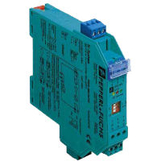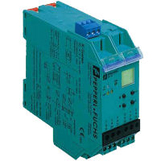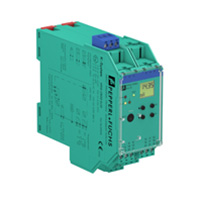The highly functional pulse evaluation units process a frequency signal at the input. Depending on the version, NAMUR or 3-wire sensors can be connected. A lead fault monitoring system signals a lead breakage or lead short-circuit on the signal cables.
On devices with a graphics display a self-explanatory menu presentation eases the adjustment of the device functions. The setting and the display of measured values can take place in a number of units. On devices with a programming socket on the front of the unit the setting can also take place using a PC.
Versions with wide range power packs are also available for international application. Five device versions are available:

The KFD2-SR2-Ex2.W.SM downtime monitor is a cost effective, easy-to-adjust pulse evaluation unit. The device functions and limit values for downtime monitoring are selected by means of DIP switches. The downtime monitor has two device functions:
- Downtime monitoring with start-up override
- Downtime monitoring with direction of rotation monitoring

The DWB speed monitor is used to monitor the speed or frequency of your plant. Two relays are available for monitoring the limit values, which can optionally be used as MIN or MAX contacts. An additional input is used for start-up override. This means the drive can be started from standstill, even when the MIN monitoring is active.

The universal frequency/ current converter UFC is a multifunctional frequency evaluation device. In addition to the frequency / current conversion it offers the possibility of monitoring the input frequency for limit values. Two limit value relays are available, which can optionally be set as MIN or MAX contacts. The input pulses can be subdivided by means of a pulse divider at the output.

The UFT has 3 integrated functions:
- Direction of rotation monitoring
- Slip monitoring
- Synchronization monitoring
In the case of the direction of rotation monitoring the direction of rotation of a rotating shaft is derived from the attenuation sequence and the overlapping of two sensor signals. In the case of slip monitoring two pulse sequences are monitored for synchronization/slip. These functions are used, for example, for the monitoring of couplings and belt drives. For these main functions the UFT has an additional analog output for frequency evaluation and switch outputs for limit value functions.

The Timer module DU offers the following time functions:
- Passing contact
- Retriggerable passing contact
- Pickup delay
- Dropout delay
- Stepping function
- Pulse expansion
- Pulse contraction
- Pulse divider
The timer is started by a trigger signal at the input. The input signal cables can be monitored for lead faults, such as lead breakage or lead short-circuit. An additional input is used to reset the running time function.







 +49 621 776-0
+49 621 776-0